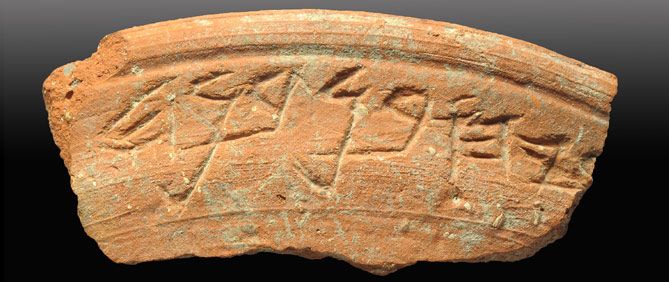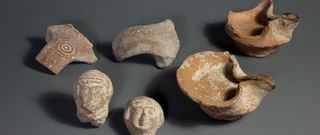Ancient Bowl With Hebrew Inscription Discovered in Biblical City

An archaeological dig in the City of David, an ancient site in Jerusalem, uncovered shards of pottery, clay lamps, figurines and a ceramic bowl with a 2,700-year-old inscription in ancient Hebrew, according to new research.
A layer of artifacts was found during a recent excavation of an area known as Gihon Spring, which was the main source of water for the City of David. The ceramic bowl, with its partially preserved inscription on the rim, likely dates back to about 600 B.C. to 700 B.C., said lead researcher Joe Uziel, an archaeologist with the Israel Antiquities Authority.
The inscription is likely the latter part of the name of an individual from the seventh century B.C., the researchers said. While Uziel and his colleagues are investigating the significance of the ancient inscription — including possible links to the Bible — the researchers say the meaning of the engraving is unknown so far. [In Photos: Amazing Ruins of the Ancient World]
"Since we only have part of the name, any direct connection to a biblical figure is speculative." Uziel told LiveScience in an email. "That said, if we reconstruct the first two letters as Z and K, we would have the name Zechariah Ben (the son of) Benaiah."
Zechariah the son of Benaiah appears in 2 Chronicles, chapter 20:14 of the Hebrew Bible, which states that Jahaziel, son of Zechariah, son of Benaiah, and member of the Hebrew tribe of Levi, prophesized before King Jehoshaphat before the nation went to war with the ancient kingdoms of Ammon and Moab.
Yet, there are still unanswered questions about this potential biblical link, Uziel added.
"Zechariah Ben Benaiah is mentioned in 2 Chronicles as a levite during the ninth century, although our bowl dates back to the seventh century B.C.," he said.
Sign up for the Live Science daily newsletter now
Get the world’s most fascinating discoveries delivered straight to your inbox.
By closely studying the bowl, the researchers determined that the inscription was made before the clay was fired, which is a process in which clay is brought up to high temperatures and is transformed into ceramic.

Still, the researchers are unsure why the ceramic bowl was inscribed, but some archaeologists have suggested the bowl may have been used to hold an offering.
"It is difficult to say with certainty what the specific use of the bowl was," Uziel said. "Usually bowls are very typical and common vessels found, used similarly to plates today, as serving dishes to eat from. However, the name inscribed on the bowl prior to its firing (the final process of making the bowl) signifies that it may have been made for a specific intention, such as the presentation of a gift or offering to someone, where the name would reflect either the recipient or more likely the presenter."
The discovery of the bowl with the 2,700-year-old inscription will be presented at Megalim's Annual Archaeological Conference, which will take place on Aug. 29 in the City of David.
Follow Denise Chow on Twitter @denisechow. Follow LiveScience @livescience, Facebook & Google+. Original article on LiveScience.

Denise Chow was the assistant managing editor at Live Science before moving to NBC News as a science reporter, where she focuses on general science and climate change. Before joining the Live Science team in 2013, she spent two years as a staff writer for Space.com, writing about rocket launches and covering NASA's final three space shuttle missions. A Canadian transplant, Denise has a bachelor's degree from the University of Toronto, and a master's degree in journalism from New York University.